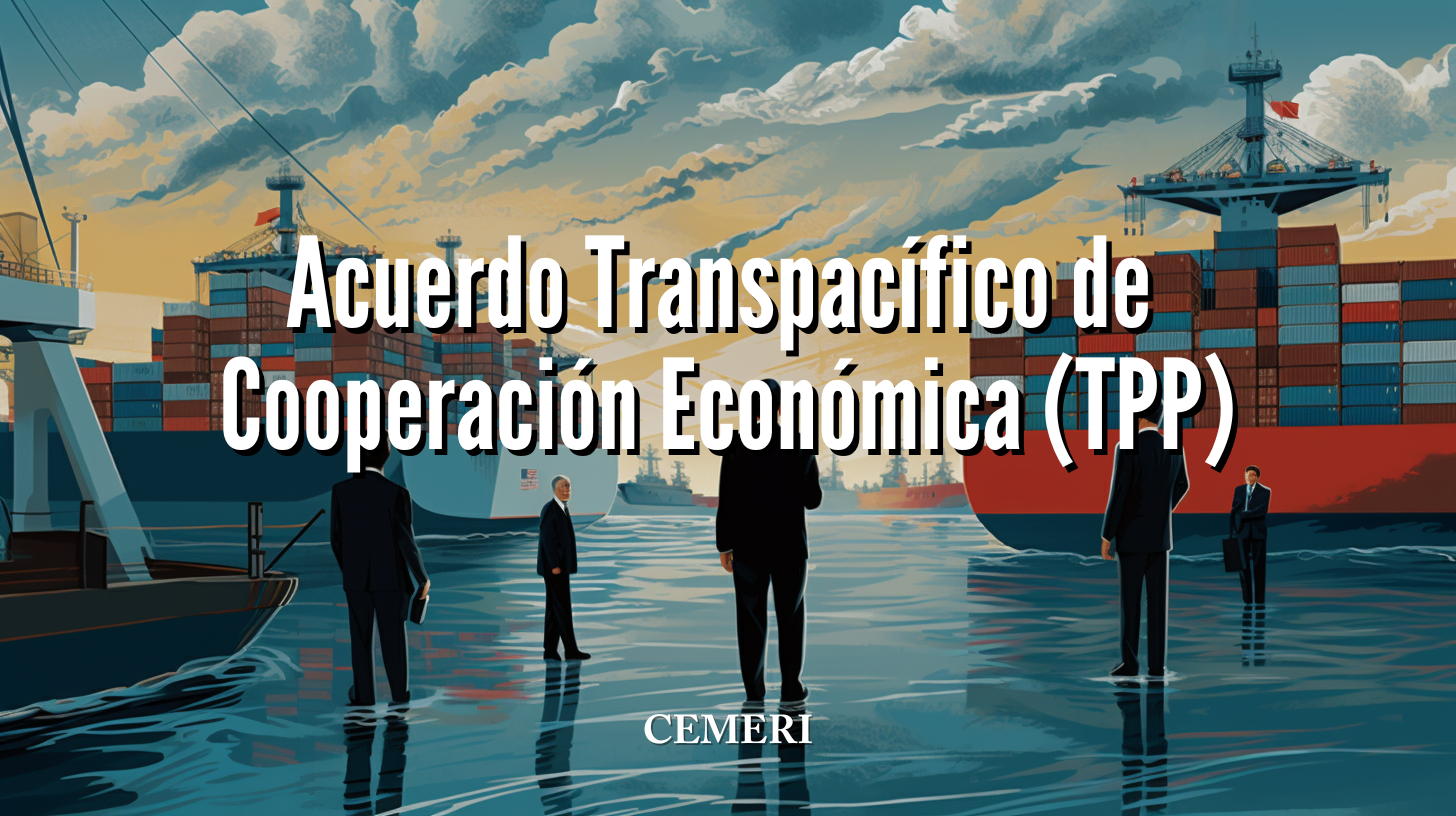Encyclopedia
Tatiana Ángeles
What is the Trans-Pacific Agreement for Economic Cooperation (TPP)?
- The TPP intends to establish the guidelines to meet three general objectives: to generate economic growth, development and employment in the member countries and to become an Asia-Pacific Free Trade Agreement.
?.webp?name=What is the Trans-Pacific Agreement for Economic Cooperation (TPP)?&format=webp&quality=55)
In the context of trade relations, several agreements have been negotiated that go beyond the guidelines set by the World Trade Organization (WTO), where these treaties are known as commercial mega-agreements due to the size and importance of the participating economies, if signed they can establish new norms in commercial relations. (Sánchez, 2014) One of them is the Trans-Pacific Economic Cooperation Agreement, more commonly known as TPP for its acronym in English: Trans Pacific Partnership, is derived as a multilateral Free Trade Agreement that promotes economic integration in the Asia-Pacific region. Peaceful.
The TPP intends to establish the guidelines to meet three general objectives: to generate economic growth, development and employment in the member countries and to become an Asia-Pacific Free Trade Agreement. It also meets five characteristics that include:
- Access to markets in a substantial way
- Regional approach that facilitates the development of production and supply chains
- Approach of new commercial challenges promoting innovation, productivity and competitiveness
- Inclusive trade, in which new elements are incorporated to ensure that companies of any size, particularly SMEs, access the benefits of free trade
- Regional integration that seeks to promote the productive chain in the Asia-Pacific region and that eventually, other economies integrate. (Secretary of Economy, 2015)
Similarly, this trade agreement arose in 2005 at the proposal of Chile, Brunei, New Zealand and Singapore (P4 Treaty), which was the first Free Trade Agreement where 3 continents participated with the possibility of adding third countries as the objective. to promote the creation of a greater strategic alliance for the liberalization of trade in the region. In this sense, on February 4, 2008, the Office of the United States Trade Representative (USTR) announced its participation in the negotiations on investment and financial services scheduled for the following March between Chile, Brunei, New Zealand and Singapore. (SICE, 2022)
In light of this, on September 22, 2008, the P4 countries and the United States announced the launch of negotiations for the latter's participation in the Trans-Pacific Strategic Economic Partnership Agreement. Subsequently, Australia, Peru and Vietnam joined the negotiations of the comprehensive agreement, that is, the Trans-Pacific Partnership Agreement (TPP), during the Leaders Summit of the Asia Pacific Economic Cooperation Forum (APEC) in November 2008 in Lima, Peru.
One year later, on November 14, 2009, the US President announced that he would collaborate with the initial group of seven TPP countries to form a regional agreement of "broad membership and the most high standards that represent the effectiveness of a 21st century agreement”. A series of rounds of negotiations were witnessed, the first round of negotiations was held between the P4 countries and the United States, Peru, Australia and Vietnam, from March 15-19, 2010, in Melbourne, Australia, while the second round of Negotiations took place in San Francisco, United States on June 14, 2010. Consecutively, the third round was held in Brunei, Darussalam, from October 4 to 10, 2010, reaching the ninth round of negotiations in Lima, Peru. , on October 20, 2011. (SICE, 2022)
These negotiations resulted from a total of 24 negotiating groups, which met to address a wide range of issues included in the agreement (important areas in national and international trade, small and medium-sized enterprises, development, regulatory coherence and competitiveness), as well as allowed the member countries of the TPP to announce the completion of the general guidelines of the agreement during the Ministerial Meeting of the 2011 Asia-Pacific Economic Cooperation (APEC) Forum.
In the same way, they were part of the entry of more countries, including Malaysia, which submitted its integration request on October 5, 2010, where it was unanimously accepted, thus allowing its effective participation as the ninth member of the TPP negotiation process. . Successively, for 2011 Canada, Japan and Mexico expressed their interest in participating in the TPP and through more rounds of negotiations, the members of the TPP were extending the invitation to each one. Finally, by 2012 Costa Rica showed its interest in also participating in the treaty.
In that year, the negotiation rounds continued until concluding with the 19th negotiation that took place in Bandar Seri Begawan, Brunei Darussalam from August 22 to 30, 2013. At that time, he clearly appreciated the leadership taken by the United States both in the negotiations and in the in invitations to participate from other States. During the following two years, the meetings had a greater presence of high-level officials, which showed significant progress, but at the same time, movements against the TPP that protested the non-viability of the TPP increased, generating conflict on issues of copyrights and invention patents. (Undersecretary of International Economic Relations, s.f.)
However, it was not until October 4, 2015 that the member countries of the TPP concluded the negotiations of the Trans-Pacific Partnership Agreement and on January 26, 2016, New Zealand published the final version in English of the text of the Association Agreement. Legally Revised Transpacific. Thus, on January 23, 2017, the Government of the United States decided to withdraw as a signatory to the Trans-Pacific Partnership Agreement and the negotiations, with the aim of only trying to establish, whenever possible, bilateral trade negotiations.
Consequently, before the criticism, the form of the negotiations and even the exit of the US, the countries had to make changes and take different measures and before this on May 21, 2017, within the framework of APEC, Ministers and Vice Ministers Trade officials from Australia, Brunei Darussalam, Canada, Chile, Japan, Mexico, New Zealand, Malaysia, Peru, Singapore and Vietnam met to discuss the Trans-Pacific Partnership (TPP). During this meeting, the Ministers agreed to initiate a process to assess options for the agreement to enter into force expeditiously, including how to facilitate the accession of the original signatories, and by November 11, 2017, they announced that they had agreed on the core elements of the Agreement. Comprehensive and Progressive Agreement for Trans-Pacific Partnership (CPTPP) that incorporates provisions of the TPP, with the exception of some provisions that will be suspended, in conclusion the 11 participating countries in the Comprehensive and Progressive Agreement for Trans-Pacific Partnership (CPTPP) reached an agreement in Tokyo, Japan and signed the agreement on March 8, 2018 in Santiago, Chile. (SICE, 2022)
Sources
Sánchez, Y. (2014). El Acuerdo de Asociación Transpacífico y sus implicaciones para América Latina. Revista Cubana de Economía y Sociedad(no. 3). Recuperado el 21 de abril de 2022, de http://biblioteca.clacso.edu.ar/Cuba/ciei-uh/20150708023245/yanaisy.pdf
Secretaría de Economía. (07 de diciembre de 2015). ¿Qué es el #TPP? Recuperado el 22 de abril de 2022, de https://www.gob.mx/se/articulos/que-es-el-tpp-17223
SICE. (2022). Acuerdo Amplio y Progresista de Asociación Transpacífico (CPTPP)) – Australia, Brunei Darussalam, Canadá, Chile, Japón, Malasia, México, Nueva Zelandia, Perú, Singapur y Vietnam. Recuperado el 22 de abril de 2022, de http://www.sice.oas.org/tpd/tpp/tpp_s.asp
Subsecretaria de Relaciones Económicas Internacionales. (s.f.). Acuerdo Transpacifico – TPP11. Recuperado el 22 de abril de 2022, de https://www.subrei.gob.cl/acuerdos-comerciales/acuerdo-transpacifico-tpp11

